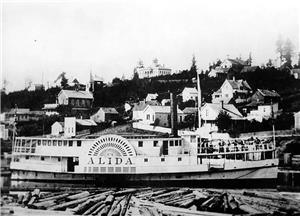On Friday, January 14, 1882, Dr. Francis B. H. Wing (1838-1882) walks to his New Tacoma office and sleeping quarters after a late-night visit with his friend R. F. Radebaugh (1846-1927) of the Tacoma Ledger. He finishes his preparations to leave the next morning for two weeks of rest in San Francisco, goes to bed, and dies before morning. He is a widower who lives alone, and his body is not found until Sunday. He is only 43, but has been "broken down by his untiring labors" fighting the smallpox epidemic that struck New Tacoma in October 1881 ("A Sudden Death"). He is hailed as a hero both for announcing the presence of smallpox, in opposition to the city's other doctors, and for caring devotedly for its victims.
The town of New Tacoma, encompassing much of what is now downtown Tacoma, had been platted in 1875 by the Tacoma Land Company, the real-estate arm of the Northern Pacific Railroad, which was planning to locate its transcontinental terminus on Commencement Bay and preferred to do so at a town it controlled rather than the existing Tacoma City -- quickly dubbed "Old Tacoma" (and now Tacoma's Old Town neighborhood) -- located a few miles north. New Tacoma was incorporated in 1880. (The two separate towns would be merged into one "Tacoma" by the state legislature in 1884.)
Misleading Letter
Early in October 1881, smallpox appeared in New Tacoma, "took hold with violence and quickly spread in all directions" (Kallsen, 20). Three New Tacoma doctors -- Henry Clay Bostwick (1828-1916), E. F. Miles, and A. M. Ballard--said it was chickenpox. Dr. Francis Wing said it was smallpox. He was right. He was also new in town, having arrived in the summer of 1880, and his insistence on a frightening epidemic was especially distasteful to Bostwick, with whom he had a joint practice. Bostwick had also co-founded the Bank of New Tacoma the previous year and had no desire to see an interruption in commerce. Drs. Bostwick and Ballard signed a notice in the October 28, 1881, issue of the Ledger, published under the heading "No Cause for Alarm," reassuring the population that those stricken had chickenpox:
"It having been circulated abroad and in the surrounding country that there has been and is now smallpox in New Tacoma, the undersigned physicians of New Tacoma, for the purpose of placing the public at ease and correcting false reports, desire to say there is not nor has there been any smallpox in this town this season" (Radebaugh).
By November, as the illness and death toll rose, resistance to identifying the disease had waned. On November 2, the Board of Trustees appointed Dr. Wing as New Tacoma's first health officer. Around the same time, he and Bostwick announced the end of their joint practice.
Wing quarantined New Tacoma homes where smallpox was present and requisitioned the Mosquito Fleet steamer Alida, which had been superseded by faster boats, and turned her into a hospital. He had her anchored two miles out in Commencement Bay and went there daily by rowboat to treat patients. On December 17, 1881, after two-and-a-half months of nonstop work as both doctor and administrator, he gave his final report to the mayor and city council. He summarized the epidemic's toll at 80 identified cases and 14 deaths and said, "I have this day discharged the last case that was on board the Alida, the hospitals are vacant, there remain but two infected houses in the city, and I hope within 10 days to remove the last yellow flag" (Radebaugh).
Wing's Short Life
Francis Bond Head Wing was born in Farmersville, Canada, in 1838 and had moved to the U.S. by his early twenties. He enlisted in the 7th Iowa Volunteer Infantry in 1861 near the start of the Civil War and was discharged a year later, after the Battle of Shiloh.
He may have returned to Canada for a period after the war. At least the Canadian patent listing for 1868 includes "Francis B. H. Wing -- A new and useful article of manufacture, the same being a Female periodical bandage" (The Canadian Almanac ...), indicating that he may have invented a menstrual pad. If so, it did not catch on. It would be another 20 years before they were first commercially available.
Wing subsequently lived in Michigan and probably attended medical school there, graduating in 1871.
He practiced in San Francisco before coming north along with his brother, Cornelius (1832-1916). He bought lots in New Tacoma and 57 acres outside of town. On his death, the property went to his widowed mother back in Iowa, Elizabeth Wing. After some more transfers, ownership of the acreage outside of town, which by 1886 had been annexed into Tacoma and multiplied in value, was challenged in a case regarding homesteader's rights that went all the way to the U.S. Supreme Court. At least briefly, Dr. Wing became better known for his real-estate investment than for his role in fighting a deadly epidemic.
Dr. Bostwick fared much better. He prospered as a banker until the Panic of 1893 economic collapse and was a founder of the New Tacoma Board of Trade, which three years later became the Tacoma Chamber of Commerce. In 1888 he became president of the newly founded Pierce County Medical Society. He left town after the 1893 collapse and died in Vancouver, Clark County, in 1916 at 87.

